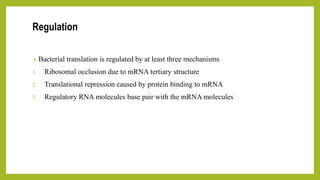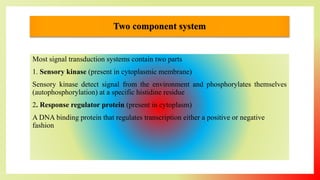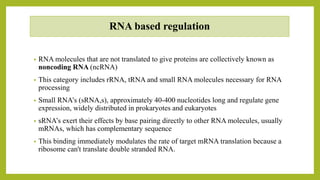Translational regulation in prokaryotes.pptx
- 1. TRANSLATIONAL REGULATION IN PROKARYOTES By Dr. YALAVARTHI NAGARAJU, Ph.D. (Ag.)
- 2. Regulation • Bacterial translation is regulated by at least three mechanisms 1. Ribosomal occlusion due to mRNA tertiary structure 2. Translational repression caused by protein binding to mRNA 3. Regulatory RNA molecules base pair with the mRNA molecules
- 4. Two component system Most signal transduction systems contain two parts 1. Sensory kinase (present in cytoplasmic membrane) Sensory kinase detect signal from the environment and phosphorylates themselves (autophosphorylation) at a specific histidine residue 2. Response regulator protein (present in cytoplasm) A DNA binding protein that regulates transcription either a positive or negative fashion
- 5. Two component systems are absent in archaea and in bacteria that live as parasites of higher organisms
- 6. • In e. coli, 50 different two component systems are present • Eg: Nitrogen limitation Phosphate limitation Osmotic pressure
- 7. Osmotic pressure regulation in E. coli • Osmolarity of environment controls the relative levels of the proteins OmpC and OmpF in the E. coli outer membrane • OmpC and OmpF are porins, proteins that allow metabolites to cross the outer membrane of gram negative bacteria • EnvZ, a cytoplasmic membrane sensor histidine kinase, detects changes in osmotic pressure • OmpR, a response regulator protein
- 8. • If the osmotic pressure is low, the synthesis of OmpF, a porin with a larger pore, increases • If osmotic pressure is high, OmpC, a porin with a smaller pore, is made in larger amounts • When a shift occurs, EnvZ auto-phosphorylates itself and transfers phosphate group to OmpR, the response regulator • Under conditions of low osmotic pressure, phosphorylated OmpR (OmpR-P) activates transcription of the ompF gene • Conversly, when osmotic pressure is high, OmpR-P repress transcription of ompF gene and activates the transcription of ompC instead • The expression of ompF is also regulated by an additional control mechanism: regulatory RNA • High osmolarity in some way triggers synthesis of an antisense RNA, the product of the micF gene. • The RNA is partly complementary to sequence in the 5’ end of ompF mRNA • The micF RNA inactivates the ompF message by annealing to it and forming a duplex RNA in vivo, which covers the translational initiation sequence of OmpF mRNA
- 9. RNA based regulation • RNA molecules that are not translated to give proteins are collectively known as noncoding RNA (ncRNA) • This category includes rRNA, tRNA and small RNA molecules necessary for RNA processing • Small RNA’s (sRNA,s), approximately 40-400 nucleotides long and regulate gene expression, widely distributed in prokaryotes and eukaryotes • sRNA’s exert their effects by base pairing directly to other RNA molecules, usually mRNAs, which has complementary sequence • This binding immediately modulates the rate of target mRNA translation because a ribosome can't translate double stranded RNA.
- 10. Mechanism of sRNA activity • Small RNAs alter the translation of their mRNA target by four distinct mechanisms 1. Base pairing with target mRNA changes the secondary structure blocks the RBS (ribosomal binding site) 2. Base pairing with target mRNA opens the blocked RBS site, llows the ribosomes to bind 3. Binding to mRNA, deceases the degradation by ribonucleases 4. Binding to mRNA, increases the degradation of mRNA quickly
- 12. • Small RNAs that are made by transcribing the non-template strand of the same gene that yielded the target mRNA are called anti sense small RNAs and are thus complementary in base sequence











